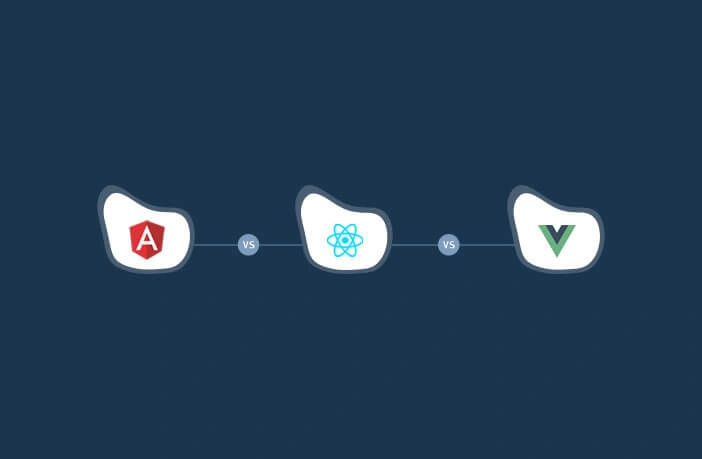Table of Contents
Where every week brings a “this framework will change everything” in IT, the debate on AngularJS vs ReactJS vs VueJS is stirring a cognitive overload in 2025. The brain-bender is less about philosophical clashes and more about developer efforts, product timelines, and realistic tech capacities.
JavaScript frameworks are the oxygen behind all modern frontend frameworks. You don’t always see them, but every feature-rich UI you build will leave you breathless without a JavaScript framework. These frameworks do the heavy lifting, so your project velocity always stays sustainable.
Each framework like AngularJS, ReactJS and VueJS has its own personality, architectural beliefs, and development nuances. Choosing the right JavaScript framework is a strategic marriage between the future-proof requirements of the client’s project, team capabilities plus various cost factors.
This blog will:
- Tell you about JavaScript frameworks and their role in modern frontend ecosystems.
- Clear up your development dilemmas on the React vs Angular vs Vue front.
- A No BS comparison of features, framework architectures and their respective use cases.
At the end of this blog, you will probably be able to choose the perfect JavaScript framework for your project.
The Role of JavaScript Frameworks in Modern Frontend Development
JavaScript frameworks, as frontend frameworks, not just help in development, but have significantly fast-tracked JavaScript development. These frameworks spare the developers from the headache of tangled DOM code and brittle fixes.
These frameworks offer a structured and scalable approach towards building reliable apps for all future versions to come.
They bring these vital values to the development scene in 2025:
Efficiency: Due to technical enhancements like Virtual DOM and ahead-of-time compilation, development speed increases, and no website page today takes 4 seconds to render.
Component-based architecture: Developers can build neat, reusable UI blocks, so they don’t have to spend time re-doing the same section or CTA buttons for the nth time.
Cross-platform coherence: Developers today smugly and confidently ‘future-proof’ your website, as these frameworks make your website/app completely cross-platform. Whether it’s a complicated website, or an MVP – these frameworks provide a smart coherent code to save costs in the future.
Productivity: An obvious benefit of such sped-up processes is developer productivity, which is enhanced due to built-in tools, big libraries, and community support on a larger scale.
AngularJS vs ReactJS vs VueJS – An overview
| Framework | Developed By | Initial Release Year | Current Version (as of June 2025) | Official Website | Popular Users |
|---|---|---|---|---|---|
| AngularJS | Google (Miško Hevery) | 2010 | 1.8.3 | angularjs.org | Google, DoubleClick |
| ReactJS | Facebook (Jordan Walke) | 2013 | 18.x | react.dev | Facebook, Instagram, WhatsApp |
| VueJS | Evan You | 2014 | 3.3.x | vuejs.org | Alibaba, Xiaomi, GitLab |
What is AngularJS?
AngularJS is a powerful, open-source JavaScript framework that was built by Google. Designed for building rich, single-page web applications (SPAs), AngularJS does not just augment HTML; it boldly extends it with more syntax. You can then build interactive, modular UIs without having to handcode each and every feature, or button repetitively.
At its heart are three technical words that explain the hype of the AngularJS framework:
two-way data binding (helps you to update UI and model both at once), dependency injection (so that your components stop clinging to hard-coded lifelines), and a Model-View-Controller (MVC) architecture, which is Google’s equivalent of organizing and giving a product structure.
With its declarative paradigm, you can declare UI components and behavior in HTML, turning markup itself into a programming language.
With a declarative paradigm, the developers can describe the UI components and behaviour in HTML, which turns markup into a programming language on its own. This makes AngularJS the best framework for building dynamic web apps that can grow far beyond the prototyping phase.
Key Benefits of Using AngularJS
- Two-Way Data Binding: The trick that defines AngularJS is that it automatically syncs the model and view. Any UI update syncs with the underlying data model dynamically—and vice versa— which frees the developers from manual DOM manipulation and bugs. This real-time data stream shines best in highly interactive apps that need to be updated often.
- MVC/MVVM Architecture: AngularJS neatly divides data(model), UI(view), and business logic/controller/view-model, bringing order to what could be a spaghetti situation. This code division isn’t just organized; it gives a huge boost to maintainability, scalability, and testability, which is essential for enterprise projects.
- Dependency Injection: This framework’s directives let you write reusable, custom HTML attributes and elements in AngularJS, which extends HTML’s limited repertoire. This modularity is especially beneficial in custom web application development, as it helps build rich, interactive UIs without bulky markup.
- SPA Support: For single-page apps, AngularJS provides the best navigation and app-like speed. Its routing and templating capabilities dynamically update content without refreshing entire pages. This kind of proactive method increases responsiveness and keeps all visitors coming back to your website or app.
- Declarative UI: Enabling developers to leverage HTML as a template language, AngularJS promotes a declarative approach towards design. It speeds up design and makes the designer as well as the developer collaboration smart and smooth.
Limitations of AngularJS
- Mandatory JavaScript Support: To execute, AngularJS apps require JavaScript to be enabled in the browsers. It won’t work on outdated equipment or where JavaScript isn’t enabled.
- Performance Bottlenecks: The two-way data binding that is so beloved by AngularJS becomes a two-faced coin. On large-scale/high-traffic apps, when there are lots of bindings, the digest cycle becomes sluggish with lag and decreased responsiveness.
- Steep Learning Curve: AngularJS developers have trouble sometimes due to absence of documentation and libraries. The developers stay stuck in a training mode, while deadlines do not stop.
- SEO Problems: Like most single-page apps, AngularJS has SEO problems. Content is rendered from the client-side in AngularJS, and search engine crawlers find it tough to discover the content.
- Boilerplate Code and Maintenance: Even simple projects in AngularJS demand large amounts of boilerplate code. With redundant version updates from AngularJS, maintaining codebases becomes all about patchwork fixes.
Ideal Use Cases for AngularJS
- Single Page Applications (SPAs): Where dynamic content updates and navigation updates are compulsory, AngularJS is a good option. It keeps users clicking without pages reloading repetitively and avoids high bounce rates.
- Enterprise and Large-Scale Applications: Angular is a reliable workhorse favored by enterprises, as these kinds of enterprise projects are complex and development companies do not need chaos while executing these enterprise-level projects.
- Dynamic Web Applications: Apps that always have real-time updates, like dashboards, analytics or team collaboration, can be developed via AngularJS. It turns flooding data streams into organized data easily.
- Form-Intensive Applications: Robust form handling, validation and dynamic form generation by AngularJS is great for apps with high data complexity. For e.g. CRMS, CMSs or such kind of data-intensive applications where one wrong key-stroke can cost dollars.
- E-commerce Platforms: Managing dynamic product catalogs and real-time user interactions is easy with AngularJS. Its speed and responsive capabilities turn normal ecommerce store visitors into loyal customers.
Real-World Applications Using AngularJS
AngularJS has powered some of the world’s most recognizable web platforms, showcasing its scalability and versatility:
- Netflix: Uses AngularJS for its dynamic UI, animations, and component-driven design.
- PayPal: Depends on AngularJS for secure, real-time transaction interfaces and dynamic dashboards.
- Upwork and Freelancer.com: Both major freelance marketplaces lean on AngularJS to handle complex, interactive interfaces.
- The Guardian: Employs AngularJS for its news platform for a global audience hungry for the latest headlines and less reloading.
- Weather.com: Powers real-time forecasts and interactive data visuals with AngularJS components to keep users aware of all weather conditions.
Build faster with our AngularJS development services
What is ReactJS?
ReactJS is a declarative and component-based JavaScript library that is developed by Facebook and relies on reusable components, plus a virtual DOM to update and render UI elements. Nobody has time for full-time page reloads in 2025, and ReactJS avoids just that. It breaks complex interfaces into organized chunks and maintains high performance as well as the most demanding user experiences.
Key Benefits of ReactJS
- Component-Based Architecture: ReactJS allows developers to build encapsulated components that can manage their state and logic. This makes code easy to test, reuse, or maintain, even when the app grows to a massive size.
- JSX Syntax: JSX in ReactJS merges HTML-like markup into JavaScript and makes UI development quite easy. It also makes code almost readable to humans and catches bugs before users see them.
- Virtual DOM: The virtual DOM tracks changes and updates only the parts which need changes. This way, the app / site’s performance impresses users the most.
- Unidirectional Data Flow: With one-way data binding, the data flow is kept predictable, and debugging also becomes simpler.
- Hooks and Functional Components: Functional components are given real power by hooks. Without boilerplate bloating up, you can easily manage state, side effects and context.
- Rich Ecosystem and Community: React’s ecosystem is vast. All libraries, tools, and developer support speed up your project development to deliver plug-and-play solutions.
- Cross-Platform Development: React Native brings React’s ideology to mobile and allows developers to reuse code and maintain UI consistency.
Limitations of Using ReactJS
- Learning Curve for Advanced Patterns: Getting started with React is easy, until you come across higher-order components, render props and hooks.
- Boilerplate and Setup: React is a JavaScript library, but not a full front-end framework. You might need to duct-tape libraries for routing, state, and APIs.
- Frequent Updates: React evolves quickly. This is innovative to an extent, but you also have to face endless compatibility issues and QA issues.
- SEO Limitations: React’s client-side rendering is great for speed, less so for visibility. Search engines get confused, and while SSR options like Next.js exist, they come with extra architectural baggage that needs careful unpacking.
- Prop Drilling and State Management: Prop drilling can tangle your code. You will need Redux, Context API, or smart development skills to keep things running smoothly in larger apps.
Best Use Cases for ReactJS
- Single-Page Applications (SPAs): React is needed in SPAs if real-time content updates and fluid user interactions are needed.
- Complex, Interactive UIs: Apps with complex and interactive features like Dashboards, data visualization tools, and team collaboration tools.
- Cross-Platform Projects: React + React Native means you can write your code once and use it in many cross-platform projects.
- Real-Time Applications: Chat apps, live feeds, and platform that needs to update fast in milliseconds, requires ReactJS.
- Component Libraries and Design Systems: For teams tired of re-coding buttons, React’s modularity makes it ideal for scalable design systems and reusable UI components.
Real-World Applications Using ReactJS
ReactJS fuels some of the world’s most performance-hungry platforms:
- Facebook: It invented React, and uses the framework for feeds, notifications and other features daily.
- Instagram: Fully built on React, every like, story and filter you see lands instantly via reusable components.
- WhatsApp Web: React keeps the messaging interface of WhatsApp quick and synced.
- Airbnb: Search, book and browse maps quickly with the quick loading and the dreamy UI in the backend.
- Netflix: React is the reason behind the binge-watchable UI staying buttery smooth.
Build fast, interactive UIs with our ReactJS Development Services
What is VueJS?
VueJS is an open-source, progressive JavaScript framework for constructing user interfaces and single-page applications. Founded by Evan You, Vue is the best for simplicity, flexibility, and performance.
Its component-based architecture, reactive data binding, and virtual DOM make it a lightweight yet robust framework for constructing contemporary web applications. VueJS is also incrementally adoptable—ideal for devs who desire to modernize their code without rewriting the universe.
Key Benefits of VueJS
- Simplicity and Easy Learning Curve: VueJS is famous for its clean syntax and due to the familiarity with HTML, CSS and JavaScript, developers can quickly onboard it.
- Lightweight and High Performance: With a gzipped core library of just 18-20KB, VueJS loads faster and quicker. The virtual DOM avoids re-renders and keeps the UI performance on point.
- Component-Based Architecture: VueJS lets developers build the most modular and reusable components for bundling template, logic, and style in one package. There is cleaner code, and overall, the bugs are less.
- Reactive Two-Way Data Binding: Vue’s reactivity keeps data and UI both in sync, and it makes real-time updates easy. This way, your apps breathe and live data.
- Comprehensive Documentation and Ecosystem: They have a really thorough documentation, which when developers read, it practically looks like you are reading a bed-time book. There are also official libraries for routing, state and tooling where devs can ship really fast with few stack overflows.
Limitations of Using VueJS
- Smaller Ecosystem Than React/Angular: Vue’s ecosystem is great, though; it’s not the giant shopping mall that React or Angular is. For specific cases, third-party libraries will be easier to integrate and work.
- Fewer Enterprise-Level Adopters: Although it has taken off, VueJS trails in Fortune 500 support. This can lead you to question long-term support and leave you searching for unicorns at a startup conference.
- Language and Community Fragmentation: Vue’s popularity in the markets in Asia, particularly China, occasionally leads to plugin docs and community threads that need translation and interpretation—yet another obstacle for worldwide teams.
- SEO Problems: As with the majority of client-side JavaScript frameworks, VueJS has issues with SEO in SPAs—unless server-side rendering is used. But server-side rendering comes with architecture issues that aren’t everyone’s cup of tea.
- Fast Evolution: Vue’s fast evolution keeps it up-to-date—but also places devs in a cycle of learning, updating, and speculating whether today’s syntax will make it tomorrow’s changelog.
Best Use Cases for VueJS
- Single-Page Applications (SPAs): Vue’s data binding makes VueJS the best SPAs that need easy content updates without reloading pages frequently.
- Progressive Web Apps (PWAs): Lightweight and offline-friendly, VueJS is great for PWAs that act like native apps.
- Prototyping and MVPs: When time is short and budgets are shorter, Vue’s fast setup helps teams develop products quickly as soon as ideas are identified and taken into action.
- Legacy Project Integration: Vue plays well with old code, as you can plug it in piece by piece. No code rewrites are required.
Real-World Applications Using VueJS
- Alibaba: As slow code does not work in ecommerce, Vue is used to speed up development on this platform.
- Xiaomi: Slick, interactive product pages are what Vue provides, and users see the ‘buy’ button long before their phone screens are dimmed.
- GitLab: It is powered by a modular frontend with Vue. Maintaining large codebases without breaking down is what Vue enables.
- Nintendo: This platform leverages Vue for web interfaces as dynamic as their game titles.
- Codeship (CloudBees): This platform switched to Vue, and there were fewer crashes, faster UIs, and happier users without much hassle.
Build Lightweight and progressive apps with our VueJS development services.
AngularJS vs ReactJS vs VueJS – Which is the best choice for you?
| Feature / Criteria | AngularJS | ReactJS | VueJS |
|---|---|---|---|
| Architecture Pattern | MVC (Model-View-Controller), modular | Component-based | MVVM (Model-View-ViewModel), component-based |
| DOM Handling | Real DOM with change detection | Virtual DOM | Virtual DOM with reactive system |
| Language | TypeScript (primarily), JavaScript | JavaScript, JSX | JavaScript, HTML-based template syntax |
| Data Binding | Two-way (bi-directional) & one-way | One-way (unidirectional) | Two-way (bi-directional) |
| State Management | Built-in (RxJS, NgRx) | External (Redux, Context API, MobX) | Vuex (official), Pinia |
| Routing | Built-in (Angular Router) | External (React Router) | Vue Router (official) |
| Performance | Good, but can lag with large data sets | Fast, optimized with virtual DOM | Fast, especially for small to mid apps |
| Learning Curve | Steep (complex concepts, TypeScript) | Moderate (JSX, advanced patterns) | Easy (simple syntax, fast onboarding) |
| Mobile Support | Ionic Framework, NativeScript | React Native (official) | Weex, NativeScript |
| Testing Tools | Jasmine, Karma, Protractor | Jest, Enzyme, React Testing Library | Mocha, Chai, Vue Test |
| SSR Support | Supported (Angular Universal) | Supported (Next.js, React Server Components) | Supported (Nuxt.js, custom SSR setups) |
| Community & Ecosystem | Large, enterprise-focused, many tools | Vast, highly active, rich ecosystem | Growing, strong open-source community |
| Use Case Suitability | Large-scale, enterprise, complex SPAs | Dynamic UIs, SPAs, cross-platform apps | Lightweight apps, rapid prototyping, SPAs |
AngularJS vs ReactJS vs VueJS: Choosing the Right JavaScript Framework for Your Next Project
Selecting from AngularJS vs ReactJS vs VueJS is not a trivial tech decision but a long-term strategic wager on the future of how your app evolves, behaves, and endures in production. Each JavaScript framework has its appeal: AngularJS excels in big, enterprise-sized worlds where opinions are integrated in; ReactJS drives interactive UIs and cross-platform builds with unparalleled flexibility; VueJS performs and meets deadlines with ease and has a really fast setup.
The “best” stack? That’s on the capabilities of your team, complexity of your app, and number of meetings you can avoid in upcoming refactors. Is it a heavyweight SPA, a MVP that needs to be launched in a week, or a large enterprise solution? Deciding on a tech stack now saves you time, money, and sanity.
We are AngularJS, ReactJS, and VueJS specialists at Wings Tech providing you with the expertise to select and implement the frontend framework that works best, not against, your project objectives.









